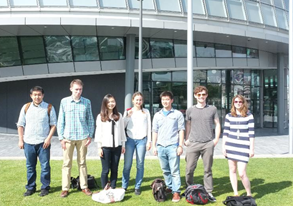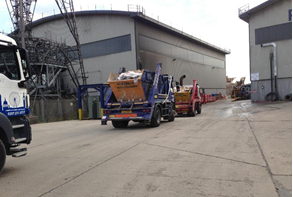Team:Imperial College/Project Evolution
From 2013.igem.org
Iain Bower (Talk | contribs) |
Iain Bower (Talk | contribs) |
||
| Line 3: | Line 3: | ||
<h2>This page explains how our ideas developed and how we implemented our human practices in the design and implementation of our project.</h2> | <h2>This page explains how our ideas developed and how we implemented our human practices in the design and implementation of our project.</h2> | ||
| - | + | [[File:Plastic tortoise.png|right|300px|]] | |
| - | + | ||
| - | + | ||
| - | + | ||
| - | [[File:Plastic tortoise.png| | + | |
We were shocked by the effects our large production of waste, particularly plastic waste and the effects this is having when it is disposed of. We thoroughly investigated the impacts and methods of waste management and decided we could add to the current system by offering a disposal route for plastics which would reduce environmental harm and provide a way to recover the resources in the waste. | We were shocked by the effects our large production of waste, particularly plastic waste and the effects this is having when it is disposed of. We thoroughly investigated the impacts and methods of waste management and decided we could add to the current system by offering a disposal route for plastics which would reduce environmental harm and provide a way to recover the resources in the waste. | ||
| Line 15: | Line 11: | ||
Our original thought was to produce biofuel from the waste. However, the 8% of annual crude oil production which is used in the production of plastics is still lost after incineration. We wanted to produce a sustainable product which could be used in a more sustainable economy, keeping the carbon in the plastics out of the atmosphere. Producing poly-3-hydroxybutyrate from the waste can do just that and can lead to a reduction in dependence on oil derived plastics in the first place. | Our original thought was to produce biofuel from the waste. However, the 8% of annual crude oil production which is used in the production of plastics is still lost after incineration. We wanted to produce a sustainable product which could be used in a more sustainable economy, keeping the carbon in the plastics out of the atmosphere. Producing poly-3-hydroxybutyrate from the waste can do just that and can lead to a reduction in dependence on oil derived plastics in the first place. | ||
| + | <br><br><br> | ||
[[File:City hall.png|left|300px| ]] | [[File:City hall.png|left|300px| ]] | ||
Revision as of 19:25, 4 October 2013
This page explains how our ideas developed and how we implemented our human practices in the design and implementation of our project.
We were shocked by the effects our large production of waste, particularly plastic waste and the effects this is having when it is disposed of. We thoroughly investigated the impacts and methods of waste management and decided we could add to the current system by offering a disposal route for plastics which would reduce environmental harm and provide a way to recover the resources in the waste.
Our original thought was to produce biofuel from the waste. However, the 8% of annual crude oil production which is used in the production of plastics is still lost after incineration. We wanted to produce a sustainable product which could be used in a more sustainable economy, keeping the carbon in the plastics out of the atmosphere. Producing poly-3-hydroxybutyrate from the waste can do just that and can lead to a reduction in dependence on oil derived plastics in the first place.
On our visit to the mixed recovery facility (MRF) Powerday we had a meeting with one of the managers and discussed the waste industry. We found that our original plan was not realistic in the current industrial setting as the plastics we wanted to degrade still have a lot of value. They can also already be recycled providing they are large enough to be separated. Reinforcing our meeting with Imperial’s waste management services, we were informed that it is the mixed waste that is the issue. Industrially for the MRFs this is a large expense. They must pay to dispose of the waste, amounting to millions of pounds a year. In this case this involves shipping the waste to Europe where it is incinerated. It was at this point that we decided to use this mixed waste as hundreds of thousands of tonnes of it are produced each year which cannot currently be recycled and MRF owners are searching for a cheaper and greener option.
Project Genesis
Brainstorming

Being inspired at SB6

Sharing ideas at YSB

Brainstorming ideas:
Bacterial Consortia
Control of synthetic microbial consortia is a desirable step in achieving increased potential in the field of synthetic biology. Advantages include the production of more complicated metabolites, the ability to optimize individual pathway production, higher level logic gates and into the future, self regulating communities, approaching the abilities of multicellular organisms. Populations in a community interact in different ways producing mutualisms, commensalisms and parasitisms. In order to rationally control communities we must understand how these different relations can form. Investigations in synthetic systems have focused on mutual dependence through the use of auxotrophic strains, toxin-antitoxin systems and antibiotic resistance modules. Control systems are currently based upon chemically relieved transcriptional repression which is precise in neither time or space. We aim to utilize different light inducible two component systems to control community interactions. We will use this to control the mutual dependency and investigate the conditions under which the above relationships form. We will also disturb the system to investigate the exchange of metabolites as an analogue to a financial system.
Synthesis of a biological scaffold using bacteria
Our project looks at generating self-sustaining Turing patterns from quorum sensing molecule AIP and bacterial swimming in a B. subtilis chassis. Once the Turing patterns are formed, the cells propagate until they reach high density, upon which they begin biosynthesis of two biomolecular polymers: γ-PGA and bacterial collagen. These are secreted into the ECM, forming a biocompatible, non-immunogenic, and bio-degradable matrix that contains pores and is able to absorb water. Removing the bacteria is then achieved in a non-invasive means by using the magnetosome within the bacteria to displace them from the scaffold, which can then be prepared for stem cell seeding or use in addition to this an ECM protein that binds to the matrix and has the capability of augmenting catalytic efficiency.
OR
Our project looks at generating self-sustaining Turing patterns from the use of bioluminescence and bacterial swimming in a B. subtilis chassis. Once the Turing patterns are formed, the cells propagate until they reach high density, upon which they begin biosynthesis of two biomolecular polymers: γ-PGA and bacterial collagen. These are secreted into the ECM, forming a biocompatible, non-immunogenic, and bio-degradable matrix that contains pores and is able to absorb water. Bacteria will not excrete these proteins in the presence of blue light. Removing the bacteria is then achieved in a non-invasive means by using the magnetosome within the bacteria to displace them from the scaffold, which can then be prepared for stem cell seeding or use in addition to this an ECM protein that binds to the matrix and has the capability of augmenting catalytic efficiency.
RNA world: orthogonal system to report on internal environment of E.coli cells in real time
Our system is designed to report the internal metabolic environment of cells through an RNA- only pathway. The advantage for relying on RNA for this signalling process is for speed, rather than relying on the time and resource consuming process of gene expression. The input of this system is the different metabolites within the cell. Different metabolites can bind to different RNA aptamers to induce a conformational change in the RNA and exposure of a sequence which displaces with one strand in an RNA biosensor. The second strand in the biosensor is then free to anneal with and change conformation of other RNAs, in a specific manner. This exposes different RNA-fluorophore aptamers and causes fluorescence. Different metabolites will produce a different palette of fluorescence. After generating a toolbox for this process, we could expand this technology to regulatory functions and utilizing different cell types.
Dopamine Production and Release in E. coli
Our project aims to engineer E. coli to produce a therapeutically important neurotransmitter, dopamine, by rewiring EnvZ-OmpR two-component system. We focus on activating dopamine production from tyrosine in response to a symptom of hypertension. Potential input signals could be concentration changes in oxygen, triglycerides and glucose. Once stimulated, EnvZ-OmpC TCS induces expression of enzymes involved in dopamine synthetic pathway. Therefore, the engineered E .coli forms an automated machine that efficiently controls the blood pressure without the need of frequent blood pressure check.
 "
"







